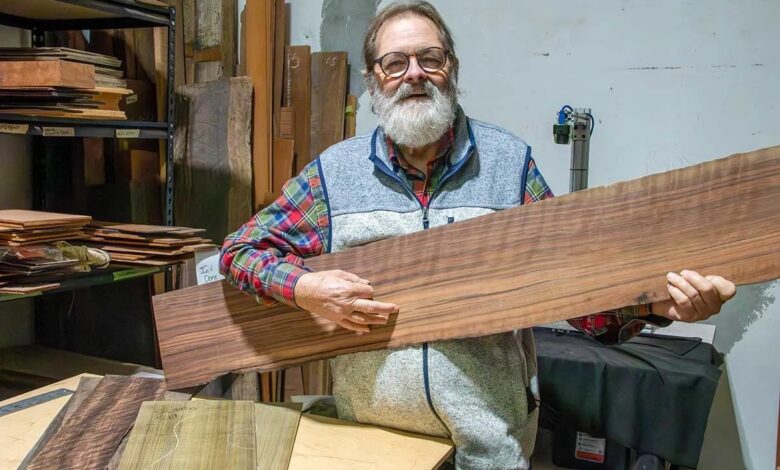Santa Cruz Guitar Company’s Richard Hoover Brings out His Choicest Tonewoods for the Stunning New Vault Series

Photos by Joshua Huver
Not long ago, Richard Hoover, the charismatic leader of Santa Cruz Guitar Company, in Northern California, reflected on his life in lutherie and the stash of precious tonewoods that he had been gathering throughout his five decades in the boutique business—everything from ancient kauri to sinker redwood to old-growth Brazilian rosewood.
“Ever since I started getting wood for guitars, I’ve come across pieces that were just too good to use and set them aside for later,” says Hoover, 74. “And now that it’s later, I wanted to do something with this legacy and make some guitars using not just the prettiest but the rarest, the most unobtainable and irreplaceable stuff.”
Hoover decided to enlist a team of the most skilled luthiers in his workshop to build a limited series of instruments that would represent the pinnacle of his artistry, and the state of the art of the steel-string guitar. The series—dubbed the Vault, a reference to the opening of Hoover’s prized wood reserves—made its official debut last January at the NAMM show in Anaheim, California. “I wanted to see how the public would react, because you and I know that it can be cringeworthy for a guitar maker to do something like this,” Hoover says. “But the guitars were really well received; people understood exactly what they were about.”
The Vault series currently includes four custom instruments: a dreadnought and an orchestra model as well two smaller Santa Cruz–designed bodies, the FireFly and the H13. Each model is built from a rare set of tonewoods and decked out with superfine ornamentation, including a tastefully encased headstock jewel. “These pieces truly have added value,” Hoover says. “And with them I feel that I have put together all the good stuff I have learned and acquired over the years.”
Having seen the instruments being built at the Santa Cruz shop last fall and marveled at them in their display cases at NAMM, I recently caught up with Hoover via telephone. He gave me the rundown on the background of all four of these remarkable instruments and their wood sources.
D Model
When the Santa Cruz Guitar Company was founded in 1976, the dreadnought was Richard Hoover’s bread and butter, as smaller body sizes like the OM, 0, and 00 had yet to see their modern resurgence. So it was only fitting for the Vault series to include a dread, and Hoover pulled all the stops for this D Model.
The back and sides are made from an exquisite set of Brazilian rosewood that was recently discovered in storage on the grounds of the Bryn Athyn Cathedral in Pennsylvania. This wood was originally used for interior details during the building’s construction in the 1910s. A selection of spare boards had been set aside for repairs and remained untouched for 100 years, until Hoover procured it for making guitars. The soundboard of the dread was made with a portion of a redwood beam salvaged in Northern California from the historic Fort Ross Chapel, which was destroyed by a fire in 1970, after having been rebuilt following a 1906 earthquake.
The guitar’s opulent embellishments include 45-style abalone purfling, rosette, and back strip; a new inlay style called Moderne Vault on the fretboard and bridge feet; and backlit tortoise (with a layer of white celluloid underneath to accentuate the tortoiseshell effect) neck and body binding. Then there’s the heel cap with a scrimshaw of the Bryn Athyn Cathedral and an ethically sourced diamond displayed behind a window in the headstock.
“We put the second-best redwood I’ve ever seen on this one,” Hoover says. “What makes it so special is that it grew in an undisturbed environment where it had been stable for millennia. And Fort Ross is on this sloping green meadow going down to the rocky seashore. It’s really moving to be there; I feel connected to this redwood on a spiritual level.”
OM
Feeling somewhat limited by Santa Cruz’s initial focus on dreadnoughts, Hoover was relieved to begin making orchestra models in earnest in the 1980s, ramping up to offer them in greater numbers after Eric Clapton famously played his 1939 000-42 in 1992 on MTV Unplugged.
This Vault example was built with master grade Brazilian rosewood that had been sitting in Hoover’s personal collection for decades. The soundboard was fashioned from 3,000-year-old Sitka spruce, with dark and dramatic coloration, recovered from the Alaskan permafrost. Snakewood binding throughout lends an elegant touch, as does the blue paua seen in the extensive 45-style inlay work and even the bridge and end pin dots. The headstock is embedded with a sapphire, and, in a subtler detail, the heel cap features a floral scrimshaw motif.
“I must have saved that Brazilian rosewood set for 40 years, just because it was so pretty,” says Hoover. “I love the wood’s movement and its color. I always figured I’d use it to make a guitar for myself, but my business got in the way.
“The heel cap design is for my own amusement,” he adds. “The forget-me-not is the favorite flower of my wife of 52 years, a designer who helped out with our inlay work for many years.
H13
The 13-fret H13 model is one that Hoover feels an especially personal connection to. Santa Cruz offers its HT/13 Happy Traum signature, and Hoover credits Traum as his inspiration to play the guitar in the first place and then delve into the world of lutherie. The H13 is also inspired by another of Hoover’s early heroes, nodding to the early 1930s Gibson Nick Lucas Special that Bob Dylan played in the 1960s.
The back and sides are inconceivably ancient kauri—around 45,000 years old—from what is now New Zealand, and the top is sinker redwood, whose rich coloring is highlighted by a gracefully shaded sunburst finish. Like the OM, this H13 sports snakewood binding, but the guitar is distinguished by its gold Awabi 45-style inlay work, as well as its 14-karat gold peghead Vault inlay, complemented by a script logo in gold Awabi. The headstock jewel is a ruby, and the heel cap sports a rococo scrimshaw design.
Hoover says, “This H13 features incredibly dense, once-in-a-lifetime redwood that came from a much higher elevation than we are [in Santa Cruz], down the San Lorenzo River. Hundreds of years ago, it got lodged in the river and took on this beautiful purple coloring from the mineral deposits. Then, during a huge storm in the early 2000s, it got dislodged and washed up on a beach near our shop. It only took about five years to negotiate using it.”
Firefly
One of Santa Cruz’s most popular guitars is its smallest—the FireFly, a travel-sized instrument designed to have a broad and sophisticated voice. Though the model takes its inspiration from old parlor guitars, it has a bold modern look and a 14th-fret neck junction‚ essentially a scaled-down version of the company’s F model.
For this build, Hoover chose micro-flamed walnut for the back and sides and peghead overlay, and a decidedly unconventional top wood, ancient sinker bald cypress. The ivoroid binding is more traditional than that on the other guitars in this series, and so is the multicolored 45-style back strip. Meanwhile, large block mother-of-pearl fretboard inlays call to mind Gibson’s Century of Progress design. Other special details include an emerald headstock jewel and a scrimshaw heel cap depicting a howling wolf.
“I grew up in the middle of the San Joaquin Valley between Fresno and Bakersfield, and before the interstates [were built], the roads between the towns were lined with black walnut trees,” Hoover says. “When the trees were cut down to widen the roads, they went straight to firewood. I remember sitting there in front of the fireplace one Christmas, looking at a piece of walnut and just getting lost in the wood’s figuring. So using it in this guitar is a personal statement, and one of my goals is to get walnut the recognition it deserves as a tonewood—right up there with rosewood and mahogany.”
This article originally appeared in the July/August 2024 issue of Acoustic Guitar magazine.



